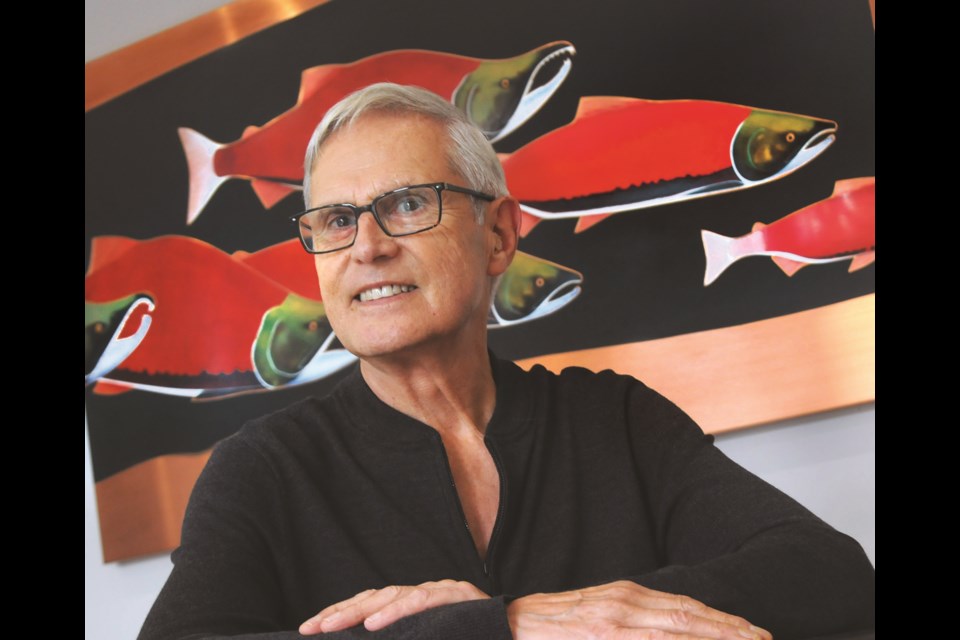It would take a visible level of restraint to not be allured by one of Wayne Buhler’s paintings.
Reflective of light and vivid in colour, looking at them is more of a compulsion than an active choice. Certainly his use of eye-catching copper, a recurring motif in all of his pieces, is novel among his North Vancouver contemporaries. It has become his glinting trademark. But Buhler attests that use of the malleable metal in art is no new concept – the material has been used by Indigenous artists for centuries.
The 79-year-old is an artist of the Simpcw First Nation, a part of the Shuswap, or Secwepemc, Nation based in B.C.'s Thompson Country. The nation’s main community resides in Chu Chua, a mining town rich in copper, where much of Buhler’s family are from.
The connection between First Nations arts and mined materials is strong. Copper would often make up much of the Simpcw nation's tools, jewellery and home ware. Buhler said he was drawn to the metal because of its bond to his ancestors, and continued with it because of its capacity to enhance his art.
“All of my paintings consist of oil paint on sheet copper,” he explained. “Light travels through translucent paint pigments I apply, is reflected by the worked copper, and returns as a super-intense colour."
Buhler was born in Vancouver, and works from a quaint North Shore studio, but hints of his native soil still remain, peppered throughout all of his creative works. Alongside the liberal use of copper there are references to the Thompson River itself. His very first series, Rivers to the Sea, is an ode to the thousands of spawning chinook, coho, pink and sockeye salmon that travel its liquid highway each year.
“It is a series that focuses solely on the fish, and their successful return," he said, adding how the paintings are designed to represent all the salmon that run through the river, not just the sockeye that he singles out. He couldn't paint any other salmon, he said, because "none are as colourful as the sockeye." His vibrant technique would be lost on any fish that doesn't bear those "beautiful red bodies and green heads."
Whether obvious or abstract, nods to the natural world can be found throughout all of Buhler's paintings. He is influenced by his memories of the lakes in Kamloops, where he would often go fishing with his uncle, or the lush forests where the two would hunt deer and elk.
Even tobacco crops contribute to his inspiration. His grandparents on his father's side had lived on the Totem Farm in Sumas Prairie, an area previously owned by the Totem Tobacco Farm Company, which still bore the crops and totem pole in the front yard. In more recent years, Buhler has been garnering inspiration from the First Nations lands where he's worked as a construction worker. No matter the time and place, it is Indigenous community and the local environment that remains at the core of his memories and creative expression.
“My understanding of the history of British Columbia has inspired me, and I think, more than anything, it's my understanding of land, of life, of nature, that gives so much creativity,” he said.
“My art envisions a healthy and natural world, and I believe we must make efforts to achieve and maintain that.”
For now, Buhler's pieces remain at his North Shore studio. He's still relatively new to the scene, so he spends his time "building bonds, creating, making connections" with others in the art world. He plans on selling his Rivers to the Sea series, meaning art appreciators have the chance to gain a small piece of Simpcw First Nation glimmering in their homes.
Mina Kerr-Lazenby is the North Shore News' Indigenous and civic affairs reporter. This reporting beat is made possible by the Local Journalism Initiative.

.JPG;w=120;h=80;mode=crop)


